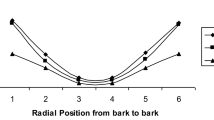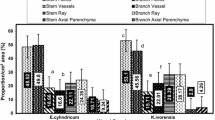Abstract
In the wake of dwindling timber resources in Ghana, the establishment of plantations has become necessary and the government and industry are actively pursuing this course. Plantations of Khaya ivorensis, which is one of the most valuable wood species, have been established in Ghana. However, concerns have been expressed by industry and stakeholders about the properties of fast-grown plantation trees compared to natural tree stands. It is believed that plantation grown species have relatively inferior wood quality to the trees from the natural stands. Wood properties such as bending strength and stiffness need to be determined to effectively recommend specific end use for the species. The aim of the study was to determine the modulus of rupture (MOR) and modulus of elasticity (MOE) of plantation-grown K. ivorensis and compare with the trees from natural stands. Plantation trees had higher strength values with a characteristic MOR of 67.35 N/mm2 compared to natural trees with a characteristic MOR of 55.27 N/mm2. Results indicated that the properties of plantation trees were not inferior to the trees from the natural forest, and even had relatively higher strength properties. Mahogany plantations are therefore recommended to ensure the sustainable supply of the species to the wood industry.



Similar content being viewed by others
References
Adam AR (1999) Timber yield determination and allocation in selective logging system in Ghana. Ghana J For 8(1999):23–30
Addae-Mensah A, Ayarkwa J, Mohammed AI, Azerengo E (1989) User’s guide of some Ghanaian secondary and primary timber species based on strength and related properties. FPRI information bulletin No. 9, p 6
Anon (1959) Oda River Forest Reserve Working plan for the period 1959–1961. Ghana Forestry Division, Accra, Ghana
Appiah-Kubi E, Kankam CK, Adom-Asamoah M (2012) Bending and modulus of elasticity properties of ten lesser used Ghanaian timber species using structural size dimensions. Ghana J For 28(1):15–28
Ayarkwa J (1998) New marketable Ghanaian timber species for furniture and construction. Wood News, July–September 1998, pp 13–18
Blair R, Olson J (1984) Impact of forest management on wood quality. In: Proceedings of symposium on utilization of the changing wood resource in the South United States, Raleigh, pp 261–269
Brunner M, Appiah-Kubi E, Zurcher N, Reinhard M, Kankam CK (2008) WAWABIMA: outstanding mechanical properties of some lesser known timber species in Ghana. In: Proceedings of world conference on timber engineering, WCTE, Japan, June 2008
BS 373 (1957) Methods of testing small clear specimens of timber. British Standard Institution, London
Cossalter C, Pye-Smith C (2003) Fast-wood forestry: myths and realities. Center for International Forestry Research, Jakarta
DIN 52186 (1978) Testing of wood: bending test. Deutsches Institute for Normung e.V., Berlin
DIN EN 384 (2004) Determination of characteristic values of mechanical properties and density. Deutsches Institute for Normung e.V., Berlin
Foli E, Agyeman VK, Pentsil M (2009) Ensuring Sustainable Timber Supply in Ghana: a case for plantations of indigenous timber species. Forestry Research Institute of Ghana, Technical Note No. 1, pp 15
Forest Products Laboratory (1999) Wood handbook—wood as an engineering material. General technical report FPL-GTR-113. US Department of Agriculture, Forest service, Forest Products Laboratory, Madison, WI, 463 pp
Gerhards CC (1982) Effect of moisture content and temperature on the mechanical properties of wood: an analysis of immediate effects. Wood Fibre 14(1):4–36
Hall JB, Swaine MD (1981) Distribution and ecology of vascular plants in a Tropical rain forest: forest vegetation in Ghana. Geobotany (W. Junked.), The Hague
Haygreen JG, Bowyer JL (1996) Forest products and wood sciences, 3rd edn. Iowa State University Press, Ames
Hoffmeyer P (1995) Wood as a building material. STEP Lecture A4. In: Blass HJ, Aune P, Choo BS, Gorlacher R, Griffith DR, Hilson BO, Racher P, Steck G (eds) Timber engineering step 1: basis of design, material properties, structural components and joints. Centrum Hout, Almere, pp A4/1–A4/21
ITTO (2004) Making the mahogany trade work. Report of the workshop on capacity building for the implementation of the CITES Appendix-II listing of mahogany. ITTO Technical Series No. 22, ITTO, Yokohama, Japan
Kojima M, Yamamoto H, Yoshida M, Ojio Y, Okumura K (2009) Maturation property of fast-growing hardwood plantation species: a view of fiber length. For Ecol Manag 257(2009):15–22
Larjavaara M, Muller-Landau HC (2010) Rethinking the value of high wood density. Funct Ecol 24:701–705
Madsen B (1975) Moisture content-strength relationship for lumber subjected to bending. Can J Civ Eng 2(4):466–473
O’Connor JP (2007) Improving wood strength and stiffness through visco-elastic thermal compression. M.Sc. thesis, Oregon State University, Corvallis, pp 56–68
Simpson WT (1992) Drying technology in tropical countries. In: Proceedings of IUFRO All-Division 5 (forest products) conference, Nancy, France, 23–28 August 1992, pp 497–507
Taylor CJ (1960) Synecology and silviculture in Ghana. Thomas Nelson and Sons Limited, London
Wessels CB, Malan FS, Nel DG, Rypstra T (2014) Variation in strength, stiffness and related wood properties in young South-African grown Pinus patula. South For 76(1):37–46
Zbonak A, Brown T, Harding KJ, Innes T, Davies M (2010) Wood properties and processing outcomes for plantation grown African mahogany (Khaya senegalensis) trees from Clare, Queensland (18 and 20 years) and Katherine, Northern Territory (14 years). The State of Queensland, Department of Employment, Economic Development and Innovation, Australia
Zobel B (1992) Silvicultural effects on wood properties. IPEF Int 2:31–38
Zobel BJ, Van Buijtenen JP (1989) Wood variation: its causes and control. Springer, Berlin
Acknowledgments
The authors are grateful to International Tropical Timber Organization (ITTO) for the support through the ITTO sponsored Project “PD 528/08 Rev. (1) F-Towards sustainable indigenous mahogany timber production in Ghana: Refining the silvicultural “toolkit” and practical training for industrial foresters and community farmers”. Many thanks to the German Academic Exchange Service (DAAD) under Fellowship Number 91526298-50015537 for the 6 months doctoral research fellowship award which provided the first author the opportunity to study and conduct part of his study in Germany.
Author information
Authors and Affiliations
Corresponding author
Rights and permissions
About this article
Cite this article
Appiah-Kubi, E., Kankam, C.K., Frimpong-Mensah, K. et al. The bending strength and modulus of elasticity properties of plantation-grown Khaya ivorensis (African Mahogany) from Ghana. J Indian Acad Wood Sci 13, 48–54 (2016). https://doi.org/10.1007/s13196-016-0165-7
Received:
Accepted:
Published:
Issue Date:
DOI: https://doi.org/10.1007/s13196-016-0165-7




